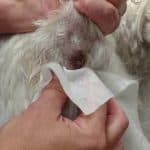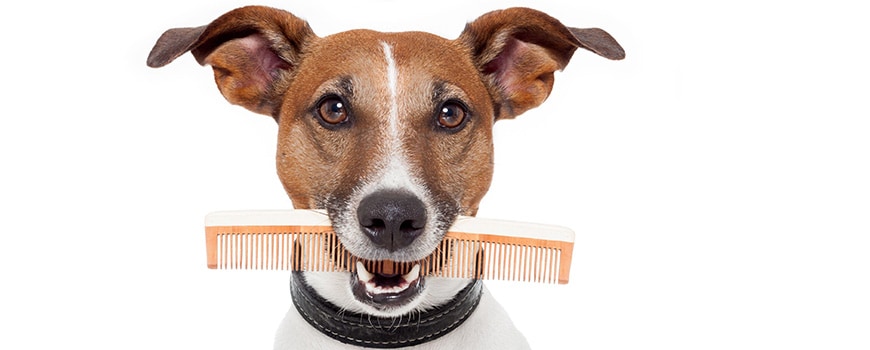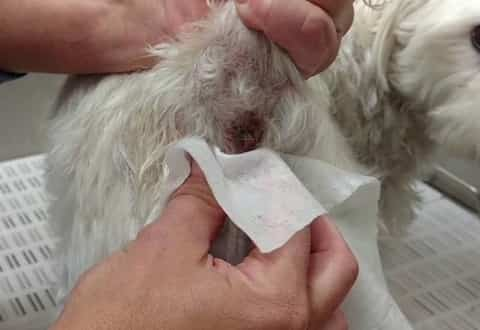Every dog has a pair of anal glands situated under the skin at each side of the opening to the rectum at about five and seven o’clock positions. Each gland or sac opens into the anal area through a small duct.
It’s easy to locate these pear-shaped sacs externally (especially if they are filled) by placing your thumb on one side of the anal opening and your index finger on the other side. Unfortunately, the anal sacs can, on occasion, cause a variety of serious and painful problems.
The exact function of the anal glands is often disputed and scientists still do not know why the sacs are there at all or why they sometimes cause problems. Some experts believe that they lubricate the passage of bowel movements. Others think they are involved in sex determination – that the odor secreted by these glands enables a dog to determine the sex of another dog upon meeting.
Dogs usually meet one another by smelling the anal sac area; this has led to the assumption that pheromones (hormones that stimulate the social and sexual behavior of animals of the same species) released from the sacs play an important role in communication.
A third theory is that the anal sacs are vestigial scent glands left over from the dog’s primitive state and that they once functioned like those of a skunk to frighten away possible attackers. It is true that the skunk’s musk glands are located in the same spot as the dog’s anal glands and that the secretion from them is similar to that of the dog except for intensity of odor.
Normally, the anal glands secrete a watery, brownish fluid that empties into the rectum during defecation. Occasionally, though, the fluid is not expelled completely; the sacs become clogged and accumulate a foul-smelling mass inside. This leads to an irritation which the dog tries to relieve either by scooting (pulling himself across the carpet or floor by his hindquarters), by chasing his tail or by incessantly licking and biting at the base of his tail.
Eventually, an abscess, which is quite painful, may develop. The dog becomes listless when this happens, his eyes appear dull and he often refuses to eat or becomes constipated. Upon examination, the anus appears inflamed and so enlarged that you may notice the skin bulging over the glands.
Veterinarians say that a large number of dogs they examine have impacted anal glands and that the owners are completely unaware of what the problem is. When a dog starts scooting across the floor, the owner often consults a veterinarian, thinking that the animal has worms.
 If you are going to do most, if not all, of your Poodle’s grooming, it is important that you know about the anal sacs. You must check these sacs periodically–once a month will suffice—for impaction and empty them when necessary. How often they need to be emptied depends on the frequency of accumulation in each dog.
If you are going to do most, if not all, of your Poodle’s grooming, it is important that you know about the anal sacs. You must check these sacs periodically–once a month will suffice—for impaction and empty them when necessary. How often they need to be emptied depends on the frequency of accumulation in each dog.
Some dogs need monthly attention, while others may go from two to three months without any accumulation; and many dogs never need to have their anal sacs emptied. Impaction seems to be more common in Toy Poodles (and other small breeds), possibly because they are fed softer food than larger dogs, which are normally fed bulkier diets that produce stiffer fecal matter.
When the anal glands become clogged, they must be emptied by squeezing them to discharge the accumulation inside. Expressing the anal glands is not a pleasant job, but it must be done to prevent further infection and serious medical problems.
When you bathe your Poodle, make it a point to check the glands immediately before putting him into the tub, or do it just after you stand him in the water, since the accumulation is so pungent-smelling.
To properly empty the glands, follow these steps:
- Stand your Poodle on a firm surface. Have someone restrain your dog if necessary. Hold up the tail in one hand.
- It is necessary to cover the anus with absorbent cotton or antiseptic wipe, as the accumulation will spurt out when the glands are emptied. Hold the cotton or wipe in your free hand and place it over the anal opening. Place your thumb on one side of the anus and your index finger on the other. Gently squeeze until the contents of the glands squirt out.
- If the glands have been clogged for some time, the secretion may come out like toothpaste from a tube instead of spurting. Usually just the slightest pressure will release the accumulated fluid. If, however, your dog’s anal glands are difficult to express, pressure should be exerted in a different manner to release the accumulated matter. Try placing your finger and thumb underneath and slightly behind the glands, then squeeze gently in an upward and outward motion.
If you are not going to bathe your Poodle and there is an pungent odor after you have expressed the anal glands, moisten a washcloth or sponge with warm water and a little shampoo, and then cleanse and rinse the skin and hair; otherwise the odor will remain. The normal anal gland secretion is yellowish-brown in color, ranging in consistency from watery to paste-like, with a fetid odor. The presence of pus or blood indicates that an infection is present and a veterinarian should be consulted as soon as possible.
If you can feel an accumulation and cannot expel it, most likely the anal glands are impacted. Prompt attention is important, as they can become abscessed and even swell to the size of a golf ball. When the condition reaches this stage, consult your veterinarian immediately. He or she can insert a softening agent into the sacs with a special needle and syringe.
The impaction can be cleared within a few minutes. If not treated promptly, an abscess can also rupture spontaneously or, if it has not already opened, surgery may be necessary to drain the sacs. After drainage, treatment usually consists of injecting the sacs with antibiotics. This may be repeated several times until improvement is noted.
Check your Poodle’s anal sacs on a regular basis, and accustom him to having them emptied to avoid a buildup. The entire procedure should only take about 30 seconds of your time, and your dog will feel much better afterward. If you don’t want to empty the anal glands yourself, however, your groomer or veterinarian can do it for you. Just don’t ignore this important check. Abscessed glands are extremely painful.
External Impaction
You should be aware that Poodles (and other long-haired breeds) may suffer from outward impaction. If your dog has a soft bowel movement, a portion of the feces might cling to the hair around the anus and form a mass. The mass can harden and seal the anal opening, making it difficult for the dog to have a subsequent bowel movement.
To remedy this situation, soak the tangled hair in warm water until the mass softens and can be removed. When the hair dries, apply an antibiotic ointment to the skin.
Depending on the clip, the individual Poodle is in, keeping the hair as short as possible around and under the anus is the best insurance against outward impaction. This is a prime example of prevention being infinitely preferable to cure.

